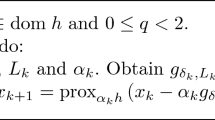Abstract
For general sparse linear programs two of the most efficient implementations of the LU factorization with Bartels—Golub updating are due to Reid and Saunders. This paper presents an alternative approach which achieves fast execution times for degenerate simplex method iterations, especially when used with multiple pricing. The method should have wide applicability since the simplex method performs a high proportion of degenerate iterations on most practical problems. A key feature of Saunders' method is combined with the updating strategy of Reid so as to make the scheme suitable for implementation out of core. Its efficiency is confirmed by experimental results.
Similar content being viewed by others
References
R.H. Bartels, G.H. Golub and M.A. Saunders, “Numerical techniques in mathematical programming”, in: J.B. Rosen, O.L. Mangasarian and K. Ritter, eds., (Academic Press, New York, 1970) pp. 123–176.
R.G. Bland, “New finite pivoting rules for the simplex method”,Mathematical of Operations Research 2 (1977) 103–107.
G.B. Dantzig,Linear programming and extensions (Princeton University Press, Princeton, NJ, 1963).
D.M. Gay, “On combining the schemes of Reid and Saunders for sparse LP bases”, in: I.S. Duff and G.W. Stewart, eds.,Sparse matrix proceedings, (SIAM, Philadelphia, 1978).
D. Goldfarb and J.K. Reid, “A practicable steepest edge simplex algorithm”,Mathematical Programming 12 (1977) 361–371.
F. Gustavson, “Finding the block lower triangular form of a sparse matrix”, in: J.R. Bunch and D.J. Rose, eds.,Sparse matrix computations (Academic Press, New York, 1976) pp. 275–289.
P.M.J. Harris, “Pivot selection methods of the Devex LP code”,Mathematical Programming 5 (1973) 1–28.
E. Hellerman and D.C. Rarick, “Reinversion with the preassigned pivot procedure”,Mathematical Programming 1 (1971) 195–216.
E. Hellermen and D. C. Rarick, “The partitioned preassigned pivot procedure (P 4)”, in: D.J. Rose and R.A. Willoughby, eds.,Sparse matrices and their applications (Plenum Press, New York, 1972) pp. 67–76.
H.M. Markowitz, “The elimination form of the inverse and its application to linear programming”,Management Science 3 (1957) 255–269.
B.A. Murtagh and M.A. Saunders, “MINOS—A large-scale nonlinear programming system (for problems with linear constraints)—user's guide”, Tech. Rept. SOL 77-9, Department of Operations Research, Stanford University, Stanford, CA (Feb. 1977).
W. Orchard-Hays,Advanced linear programming computing techniques (McGraw-Hill, New York, 1968).
A.F. Perold and G.B. Dantzig, “A basis factorization method for block triangular linear programs”, in: I.S. Duff and G.W. Stewart, eds.,Sparse matrix proceedings (SIAM, Philadelphia, 1978).
A.F. Perold, “Exploiting degeneracy in the simplex method”, Research Report RC 7713, IBM Thomas J. Watson Research Center, Yorktown Heights, NY (June 1979).
J.K. Reid, “A sparsity-exploiting variant of the Bartels—Golub decomposition for linear programming bases”, Report CSS 20, Computer Science and Systems Division, AERE Harwell, Oxon., England (1975).
J.K. Reid, “Fortran subroutines for handling sparse linear programming bases”, Report AERE-R8269, AERE Harewell, Oxon., England (1976).
A. Sangiovanni-Vincentelli and T.A. Bickart, “Bipartite graphs and an optimal bordered triangular form of a matrix”, Memorandum No. UCB/ERL M78/74, Electronics Research Laboratory, University of California at Berkeley, CA (July 1977).
M.A. Saunders, “A fast, stable implementation of the simplex method using Bartels—Golub updating”, in: J.R. Bunch and D.J. Rose, eds.,Sparse matrix computations (Academic Press, New York, 1976) pp. 213–226.
M.A. Saunders, “MINOS system manual”, Tech. Rept. SOL 77-31, Department of Operations Research, Stanford University, Stanford, CA (Dec. 1977).
Author information
Authors and Affiliations
Rights and permissions
About this article
Cite this article
Perold, A.F. A degeneracy exploiting LU factorization for the simplex method. Mathematical Programming 19, 239–254 (1980). https://doi.org/10.1007/BF01581646
Received:
Revised:
Issue Date:
DOI: https://doi.org/10.1007/BF01581646




